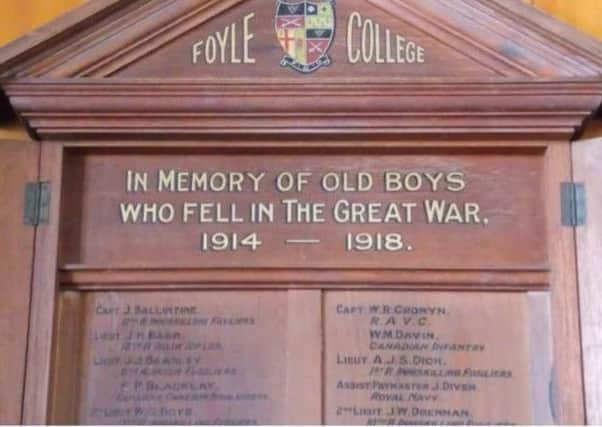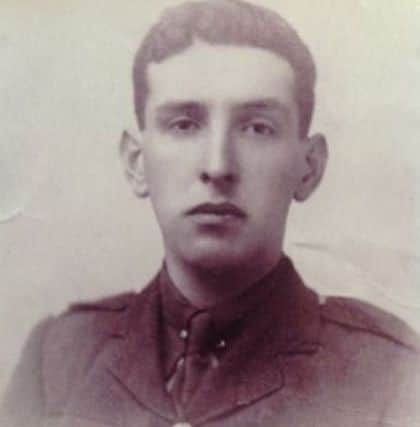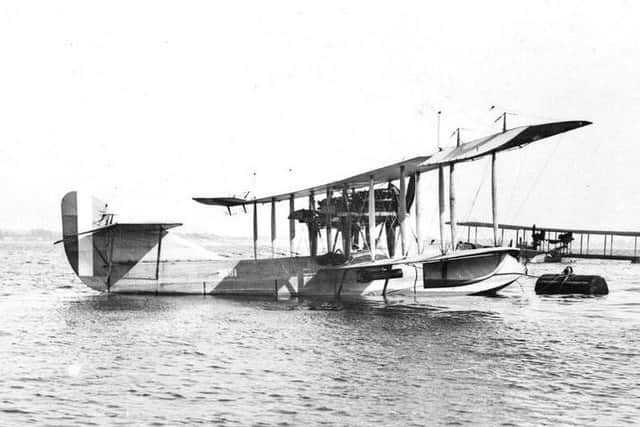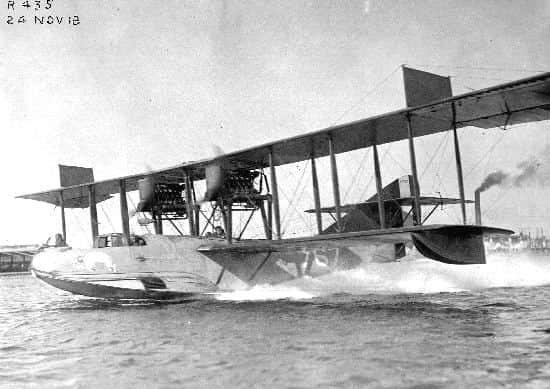Having attended the same school only one of seven heroic airmen survived the Great War


They’re commemorated on the school’s Great War memorial and on other memorials here and around the UK.
A total of 490 former pupils from Foyle College answered the call-up to the First World War and 72 made the ultimate sacrifice.
Advertisement
Hide AdAdvertisement
Hide AdOf the seven flyers, only one survived – Robert Frederick Lea Dickey, born in July 1895, the son of Professor Dickie of Londonderry’s M’Crea-Magee College.


The six who died were 25-year-old Second Lieutenant William Kerr Magill Britton; 20-year-old Lieutenant Maurice Graham English; Second Lieutenant D McConnell; 29-year-old Captain Humphrey Donatus Stafford O’Brien; 35-year-old Flight Commander Leslie Vernon Lusington Porter and Captain Edward George Harvey.
All of these brave men, and many women too, will be remembered and commemorated during next month’s centenary of the Armistice.
One of the flyers who died and the one who survived are recounted more fully on this page today as some details of their heroism have recently arrived in Roamer’s mail-box, including a heart-breaking photograph of a young airman inscribed with the words “see you all soon” and signed ‘E’.
Advertisement
Hide AdAdvertisement
Hide AdThe signature was Captain Edward George Harvey’s, who was only 18-years-old when he enlisted to fly.


After serving in South Africa and India, Harvey was seconded for service with the Royal Flying Corps in 1913.
In 1914 he was promoted to Captain and was at the head of his flying company, leading an attack on the third line of German trenches on June 16, 1915, when he was mortally wounded.
He was only 32 years old and his opportunities to “see you all soon” were tragically foreshortened.
Advertisement
Hide AdAdvertisement
Hide AdThe Foyle College flyer who survived the First World War, Robert Frederick Lea Dickey, DSC and two Bars, famously downed a Zeppelin and sank several U-boats during the Great War.


Enlisting in the Royal Naval Air Service in April 1915, he was soon appointed as a Petty Officer Mechanic, doubtlessly on account of his college days when he excelled at science and mechanics.
He became a probationary Flight Sub Lieutenant and then got his pilot’s certificate in December 1916.
Posted to Felixstowe in early 1917 he teamed up as a co-pilot to the Canadian Flight Sub Lieutenant B D ‘Billiken’ Hobbs in Curtiss H12 flying boats and commenced his operational tour on anti-submarine patrols.
Advertisement
Hide AdAdvertisement
Hide AdBut Dickey’s first successful encounter was in a spectacular air-to-air battle with a mighty German Zeppelin, south-west of Terschilling (an island in the northern Netherlands) on June 14, 1917.
At the time he was manning a Lewis gun in the front cockpit of the Curtiss H12.
When Dickey spotted the Zeppelin five miles away at 1,500 feet, ‘Billiken’ Hobbs swung up the nose of the seaplane and climbed steeply towards the Zeppelin.
The Curtiss’s wireless operator was at the midships gun, the engineer was at the stern guns, and the Zeppelin was barely moving, with her propellers merely “ticking over”.
Advertisement
Hide AdAdvertisement
Hide AdAt 2,000 feet and 1,000 yards away from the Zeppelin, a German look-out spotted the Curtiss and shouted for full power.
The Zeppelin surged forward and swung away while her gunners took aim.
‘Billiken’ dived on the Zeppelin’s tail at 140 miles an hour and Dickey fired two lethal bursts from his machine-gun.
He later said that her immense size staggered him.
Little spurts of flame stabbed out where his well-aimed bullets had torn the Zeppelin’s fabric and ignited the escaping hydrogen.
Advertisement
Hide AdAdvertisement
Hide AdWith a tremendous burst of flame, so intense that all aboard the flying-boat felt the heat, millions of cubic feet of hydrogen ignited.
She broke in half, each part burning furiously while falling towards the water.
The Zeppelin’s top gunner rolled into the flames and vanished.
Three more of her flight-crew tumbled in a hideous ‘head-over-heels’ in front of the red-hot remnants of the Zeppelin.
Advertisement
Hide AdAdvertisement
Hide AdOn impact, a thick pillar of steam and black smoke reared up from the sea.
Dickey and the crew of the flying-boat cheered and crowded into the control cockpit to celebrate with ‘Billiken’ before dashing for home.
News of their victory was initially kept secret, but both Dickey and Hobbs were duly decorated with the DSC.
A few days later Dickey was awarded a Bar to his DSC for an attack on a U-Boat.
Advertisement
Hide AdAdvertisement
Hide AdHe attacked another Zeppelin a month later, though this time without success.
Having completed around 20 further sorties, Hobbs and Dickey had their next run-in with an enemy submarine on September 3, 1917.
They dropped three 230lb bombs “which fell in place where conning tower disappeared,” Dickey noted in his log-book.
“When the submarine sank we could clearly see two men on top, but though we searched spot for 15 minutes we could not see them again. The three bombs fell within a circle of 20 yards diameter.”
Advertisement
Hide AdAdvertisement
Hide AdAnd 10 days later, after Dickey and ‘Billiken’ sank yet another U-Boat, Dickey was awarded a Second Bar to his DSC.
On April 30, he shot down an enemy plane but while employed in an operation based on a Royal Navy ship off Holland in early June 1918 his ship was blockaded and Dickey was arrested on Terschelling and interned.
After the First World War ended he remained with the RAF, served with RNVR during part of the Second World War and retired from service in March 1941.
More information about the Foyle Flyers is at www.remembranceni.org.